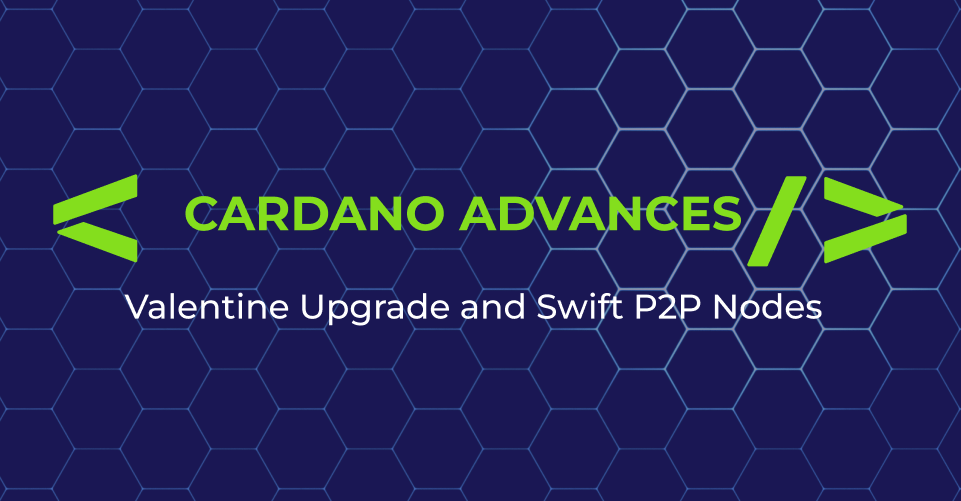Cardano Advances: Valentine Upgrade and Swift P2P Nodes Boost Blockchain Progress
Written by
Krista Alvarez
Published on
May 13, 2023
Time reading
5 minutes

Cardano, a prominent blockchain network, has made significant strides in the realms of interoperability, scalability, and sustainability since the beginning of 2023. InputOutput, the organization behind Cardano, recently detailed the network’s impressive improvements in a blog post. These advancements, both subtle and impactful, have solidified Cardano’s position as a third-generation blockchain.
The Valentine Upgrade: Boosting Cardano’s Compatibility, Scalability, and Signature Capabilities
The Valentine upgrade, rolled out in February, has been a game-changer for Cardano’s compatibility with other blockchains. Named after its release date coinciding with Saint Valentine’s Day, the upgrade enables developers to build software using smart contracts, enhancing the network’s appeal for decentralized applications (DApps). The Valentine upgrade also introduced support for the SECP256k1 curve, which is utilized by leading cryptocurrencies like Bitcoin, Ethereum, and Binance Coin for public key cryptography. This addition enables Cardano to support two more signature types, Elliptic Curve Digital Signature Algorithm (ECDSA) and Schnorr, to verify data.
The native signature algorithm, known as the Edwards-curve Digital Signature Algorithm (EdDSA), has been enhanced by these additions. As for scalability, Cardano has made considerable progress thanks to the implementation of Hydra technology. This layer 2 protocol allows developers to create their own mini blockchains and speed up processing times for applications. Hydra technology also reduces transaction costs and relieves the main chain of processing burdens.
Exploring Hydra’s Potential: IOG and MLabs Partnership, Obsidian Systems, and Dynamic P2P Integration
Input Output Global (IOG) has partnered with MLabs to develop an auction utilizing Hydra technology, showcasing its potential. In the future, the Obsidian Systems project will introduce payment processing using Hydra technology as well. Furthermore, Dynamic P2P contributes to the network’s sustainability by enabling decentralized relay nodes to interact directly with one another. This functionality is made possible by the Cardano node software’s automated communication capabilities in versions 1.35.6 and 1.35.7.
Dynamic P2P improves network security by making the network more resistant to denial-of-service (DoS) attacks. This automated process for node selection streamlines communication during transaction validation and other tasks necessary to keep it operational.

Djed Stablecoin Launch and Expanding Opportunities on Cardano
In January, Cardano welcomed another decentralized finance (DeFi) component with the launch of the Djed stablecoin. Within 24 hours, 27 million ADA backing was made available on exchanges such as MinSwap, MuesliSwap, and Wingriders. Djed, backed by six ADA tokens to maintain its stable price, will be used for payment settlements and covering network fees. The introduction of Djed paves the way for more DeFi opportunities across the entire Cardano network.
Recent advancements have propelled the network’s growth in interoperability, scalability, and sustainability. The Valentine upgrade, Hydra technology, and Dynamic P2P are just a few examples of how the company continues to innovate and solidify its position in the blockchain ecosystem. With the addition of Djed and other potential DeFi developments, the future of Cardano appears bright and promising.
Cardano Commits to Decentralized Finance (DeFi)
The introduction of Djed has significantly impacted the DeFi landscape within the ecosystem. Djed is a crucial development for Cardano, as it provides a stable asset to facilitate transactions and encourage user adoption. Furthermore, the stablecoin is expected to attract new projects and developers, ultimately boosting the network’s DeFi presence.
Another key aspect of current growth is its emphasis on governance and decentralization. The network’s governance model, called Voltaire, aims to create a self-sustaining and decentralized ecosystem by empowering community members to make decisions about the platform’s future. The introduction of Project Catalyst, a decentralized fund that enables community members to propose and vote on projects, is a testament to Cardano’s commitment to community-driven development.
Environmental Sustainability: Energy-Efficient Proof-of-Stake Protocol
The company sets itself apart from other blockchains with its commitment to environmental sustainability. The network operates using a Proof-of-Stake (PoS) consensus mechanism called Ouroboros, which is significantly more energy-efficient than the traditional Proof-of-Work (PoW) systems used by Bitcoin and Ethereum. This energy efficiency reduces the network’s carbon footprint and makes it an attractive choice for environmentally conscious users and developers.
Current growth is further fueled by strategic partnerships and collaborations with various organizations and institutions. For instance, the network has established partnerships with the Ethiopian government to improve the country’s education system through blockchain technology. Cardano has collaborated with companies like World Mobile to provide affordable internet access in Tanzania, fostering financial inclusion in the region.
Vision for the Future: A Scalable and Interoperable Blockchain Ecosystem
Current company’s roadmap, which outlines the network’s future plans, showcases its ambitious vision to become a leading blockchain ecosystem. In addition to the recent developments discussed earlier, the company aims to create an interoperable and scalable network capable of handling the needs of a global user base. This includes improvements to the network’s infrastructure, the implementation of sidechains, and the development of advanced smart contract capabilities.
To foster a thriving developer community, Cardano has launched the Developer Portal, which provides resources, documentation, and support for developers looking to build on the network. Additionally, the Plutus Playground offers a sandbox environment for developers to experiment with and test their smart contracts before deploying them on the Cardano blockchain. These resources contribute to the network’s ease of use and accessibility for developers, further driving the growth of the ecosystem.
The Growing Community: A Strong Foundation for Continued Success
The success of any blockchain network relies heavily on its community, and the growing community is a testament to the network’s potential. With an active presence on various social media platforms and a dedicated group of developers, researchers, and enthusiasts, the community plays a vital role in the network’s ongoing growth and success.
Current advancements, including the Valentine upgrade, Hydra technology, Dynamic P2P, and the launch of Djed, demonstrate the network’s commitment to innovation, interoperability, and scalability. By focusing on governance, decentralization, environmental sustainability, and strategic partnerships, The company is well-positioned to solidify its place in the blockchain ecosystem. As the network continues to grow and evolve, the future of Cardano looks brighter than ever.
Source: crypto-news-flash.com